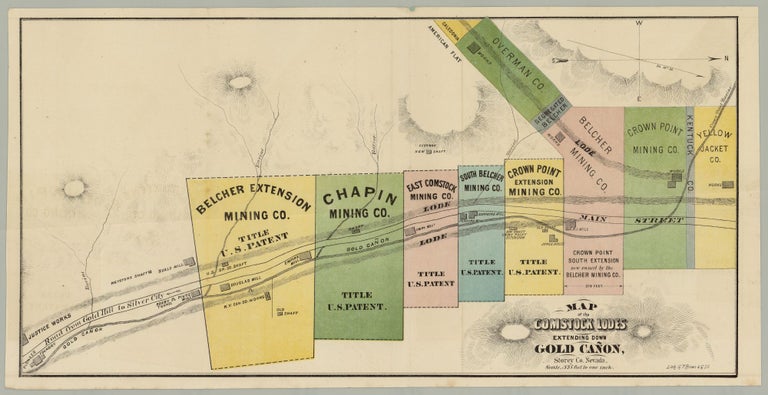Map of the Comstock Lodes Extending Down Gold Cañon, Storey Co., Nevada.
San Francisco: G. T. Brown & Co., [1865]. Chromolithographic map, 8.5” x 16.75”, plus margins. CONDITION: Very good, old folds, light wear, one minor blue stain at top middle margin. A scarce map of the Comstock Lode mining claims in Storey County in western Nevada, printed by pathbreaking African American lithographer Grafton Tyler Brown of San Francisco. This map shows eleven consecutive claims in Gold Cañon, belonging respectively to the Belcher Extension Mining Co., the Chapin Mining Co., the East Comstock Mining Co., the South Belcher Mining Co., the Crown Point Extension Mining Co., the Belcher Mining Co., the Crown Point Mining Co., the Yellow Jacket Co., the Overman Co., the Kentuck Co., and the Segregated Belcher Mining Co. A portion of the Caledonia gold mine is also depicted, extending across “American Flat” at the upper border of the map. Identified are tunnels, shafts (“old” and “new”), mills, works, a house, a foundry, as well as U.S. Patents. Main Street, the “Road from Gold Hill to Silver City” running horizontally through Gold Cañon across the center of the map, and several ravines extending upward from the canyon. It is noted that the Crown Point South Extension is, in 1865, “now owned by the Belcher Mining Co.” Relief is shown by hachure. The Comstock Lode was a rich silver ore deposit located under the eastern slope of Mt. Davidson, a peak in the Virginia Range in Virginia City, Nevada. The first major silver ore to be discovered in the U.S., it attracted many prospectors from around the world after it was made public in 1859. Mining camps in the vicinity thrived and developed into bustling commercial centers, such as Virginia City. The Comstock Lode generated massive fortunes, simulating the growth of Nevada and San Francisco, and helping to finance the U.S. government during the Civil War. Production at the Comstock mines peaked between 1876 and 1878, and declined sharply thereafter. Born in Harrisburg, Pennsylvania to free African American parents, Grafton Tyler Brown (1841–1918) was the first African American lithographer to work in California. After arriving in Sacramento in 1858, Brown worked as an illustrator, depicting new settlements and gold-rush towns for the San Francisco lithographer Charles Kuchel. Whereas Sacramento’s directories had listed Brown as “colored,” San Francisco’s directories listed the light-skinned Brown as white—giving him a professional advantage. In the early 1860s, Kuchel sent Brown to the Comstock Lode in Nevada, and Brown’s 1861 portrait of Virginia City was the first view created of that boomtown. Following Kuchel’s death in 1864, Brown purchased the lithography business, renaming it G. T. Brown & Co. In 1882 he shifted his focus to landscape painting, working extensively in the Pacific Northwest. Like his bird’s-eye views of Pacific Coast cities and towns, Brown’s landscapes were also popular during his day. In 1892 he relocated to St. Paul, Minnesota, where he worked as a draftsman for the Army Corps of Engineers until 1897, and then with the city’s engineering department until 1910. OCLC records five examples. REFERENCES: Chandler, Robert J. San Francisco Lithographer : African American Artist Grafton Tyler Brown (Norman: University of Oklahoma Press, 2017), pp. 41–47 and 194–195; Chandler, Robert. “Grafton Tyler Brown” at Britannica online.
Item #7723
Sold


